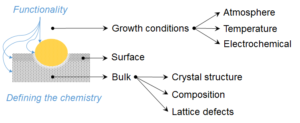
Emergent Nanomaterials is an EPSRC funded Critical Mass project led by the University of St Andrews in collaboration with the University of Newcastle, University of Bath, Imperial College London and the University of Ulster.
In recent work we have identified a very powerful and extensive phenomenon, the constrained production of nanoparticles that opens up a new field impinging on chemistry, materials science and physics. The dispersion, stability, versatility and coherence with the substrate impart quite significant properties to the emergent nanoparticles opening up a major new topic. The process is driven by the lattice decomposition of a metal oxide under reduction by various means. Conventional thinking considers this as a simple phase separation; however, by careful control of the defect chemistry and reduction conditions, a very different process can be achieved. These nanoparticles emerge from the substrate in a constrained manner reminiscent of fungi emerging from the earth. The emergent nanoparticles are generally dispersed evenly with a very tight distribution often separated by less than one particle diameter.
Here we will explore the composition and reaction space conditions necessary to optimise functionality, structure and applicability. We will also seek to better understand this phenomenology relating to correlated diffusion, driving energetics and mechanism of emergence. Further work is necessary to understand the critical dependence of composition in a very extensive domain of composition space depending upon charge and size of the A-site cations, oxygen stoichiometry and transition metal redox chemistry. Of particular importance is to understand the nature of the interaction between the nanoparticle and the substrate addressing the evolution of the nanoparticles from the surface and how the particles become anchored to the substrate. Exsolved metals can react to form compounds whilst maintaining the integrity of the nanostructural array and this offers much potential for further elaboration of the concept.
We will investigate the important catalytic, electrocatalytic and magnetic physics properties arising at constrained emergent particles, driven by dimensional restriction. Emergent nanomaterials provide very significant surface-particle interactions and promise new dimensions in catalysis. The electrochemical reactions in devices such as batteries and fuel cells are restricted to the domain very close to the electrolyte electrode interface. Emergent materials can be applied in exactly this zone.

